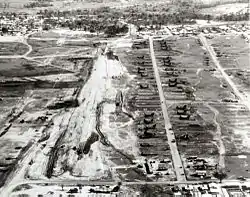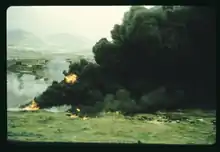Camp Radcliff
Camp Radcliff (also known as An Khê Army Airfield, An Khê Base or the Golfcourse) is a former United States Army base in the An Khê District in central Vietnam.
Camp Radcliff | |||||||
|---|---|---|---|---|---|---|---|
| An Khê, Gia Lai Province, in Vietnam | |||||||
 | |||||||
 Camp Radcliff | |||||||
| Coordinates | 13.993°N 108.648498°E | ||||||
| Site information | |||||||
| Condition | abandoned | ||||||
| Site history | |||||||
| Built | 1965 | ||||||
| Built by | 70th Engineer Battalion | ||||||
| In use | 1965-1971 | ||||||
| Battles/wars | Vietnam War | ||||||
| Garrison information | |||||||
| Garrison | 1st Cavalry Division 173rd Airborne Brigade 4th Infantry Division | ||||||
| Airfield information | |||||||
| |||||||
History
1965–67
Camp Radcliff was established in late August 1965 by the 70th Engineer Battalion as the base camp for the 1st Cavalry Division. The camp was located on the main highway, QL-19 60 kilometres (37 mi) northwest of Qui Nhơn on the coast and 60 kilometres (37 mi) southeast of Pleiku in the Central Highlands. The camp was named after 1/9 Cavalry Major Donald Radcliff, the 1st Cavalry's first combat death, who was killed on 18 August 1965 while supporting U.S. Marines in his helicopter gunship during Operation Starlite.[1]
In order to reduce the amount of rotor-blown dust on the landing zone, the men of the 1st Cavalry were instructed to cut back foliage to ground level by hand giving the base its nickname of the Golfcourse.[2] The 1st Cavalry painted their distinctive insignia on nearby Hon Cong Mountain providing a landmark visible for many miles.[1] Camp Radcliff was the largest helicopter base in the world at the time of its establishment, capable of accommodating the 1st Cavalry's 400+ helicopters. The base also had an airfield capable of landing Lockheed C-130 Hercules aircraft.[3] The base had a perimeter of 26 km known as the Green Line with 3-man watchtowers every 50m.[4]
On the night of 3 September 1966 the Viet Cong carried out a mortar attack on the Golfcourse. Starting at 21:50 the base was hit by 119 mortar rounds over a 5-minute period, killing 4 soldiers and wounding a further 76, while 77 helicopters were damaged.[5]
Other units stationed at Camp Radcliff in this period included:
- A detachment of 15th Medical Battalion with UH-1D Iroquois.[6]
- 2nd Battalion, 17th Artillery (September 1965 – February 1970)[7]
- 3rd Battalion, 18th Artillery (October 1965 – April 1967)[7]:101
- 2nd Battalion, 19th Artillery (September 1965 – 1968)[7]:101
- 1st Battalion, 21st Artillery (September 1965 – 1968)[7]:101
- 2nd Surgical Hospital (August 1965 – April 1967)[7]:213
- 15th Transportation Corps Battalion Aircraft Maintenance Support (September 1965 – 1968)
- 509th Signal Battalion (September 1966 – 1967)[7]:185
On 12 March 1967 a USAF C-130 crashed on takeoff from the base airfield.
1968–69
In January 1968 the 1st Cavalry moved to Camp Evans and Camp Radcliff was taken over by the 173rd Airborne Brigade. The 173rd stayed at Camp Radcliff until mid-1969.[1][7]:157

Other units stationed at Camp Radcliff in this period included:
- 5th Battalion, 22nd Artillery (November 1967 – 1969)[7]:101
- 17th Field Hospital (1968 – July 1969)[7]:214
- 5th Special Forces Group Detachment B-51 (September 1968 – October 1969)[7]:244
- 1st Battalion, 50th Infantry Regiment (September 1967 – April 1969)[7]:151
- 4th Battalion, 60th Artillery (June 1968-late 1970)[7]:105
- 6th Battalion, 84th Artillery (March 1968 – August 1969)[7]:107
At 02:00 on 30 October 1968 a mortar and sapper attack on the camp resulted in two South Vietnamese guards killed, four vehicles destroyed and damage to several buildings.[8] At 15:28 on 11 November 1968 a mortar and recoilless rifle attack on the camp killed four South Vietnamese civilians and ignited 13,643 barrels of POL, one Viet Cong was killed.[9]
1970–71
The 4th Infantry Division was stationed at Camp Radcliff from mid 1969 – December 1970.[7]:139
Other units stationed at Camp Radcliff in this period included:
- 7th Battalion, 15th Artillery (January to late 1970)[7]:100
- 238th Aviation Company (March 1969 – December 1971)[7]:122
Current use
The base is abandoned and turned over to farmland.
References
| Wikimedia Commons has media related to Camp Radcliff. |
- Kelley, Michael (2002). Where we were in Vietnam. Hellgate Press. pp. 5–434. ISBN 978-1555716257.
- Manick, Jack (2013). Incoming...The Men of the 70th. Author House. p. 175. ISBN 9781481734066.
- Ulin, Robert (2011). Witness to History: Reflections of a Cold War Soldier. Author House. p. 25. ISBN 9781456736163.
- Powers, Robert (2009). 1966 The Year of the Horse. Dog Ear Publishing. p. 75. ISBN 9781608442027.
- "After Action Report (3 Sep 1966 attack on Camp Radcliff)" (PDF). U.S. Army. 17 September 1966. Archived from the original (PDF) on 4 March 2016. Retrieved 27 October 2014.
- Dunstan, S (1988). Vietnam Choppers. Osprey Publishing Ltd. p. 138. ISBN 0-85045-572-3.
- Stanton, Shelby (2003). Vietnam Order of Battle. Stackpole Books. p. 101. ISBN 9780811700719.
- "After Action Report Attack on Camp Radcliff 30 October 1968" (PDF). 1st Battalion (Mechanized), 50th Infantry, 173rd Airborne Brigade. 9 November 1968. Retrieved 8 June 2020.
- "After Action Report Attack on Camp Radcliff 11 November 1968" (PDF). 1st Battalion (Mechanized), 50th Infantry, 173rd Airborne Brigade. 22 November 1968. Retrieved 8 June 2020.